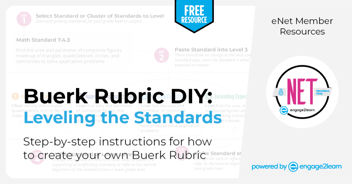How to Implement Badging and Micro-credentialing for Innovative Learning | engage2learn
Today, every business, manufacturer, retail establishment, and organization faces a talent shortage and budget pressure. New employees must possess the appropriate skills and talent to match up to the job. The same is true in public school education. Investing significant money into long training and development programs for new employees may not be an option and can be risky.
As an emerging solution, new and existing employees and educators can engage in development activities and earn badges and micro-credentials when they demonstrate proficiency in a skill or competency, innovative learning method, or coaching experience.
What is Micro-Credentialing and Badging?
Badging and micro-credentialing acknowledge and showcase educators’ learning accomplishments. Micro-credentialing and badging are often used interchangeably but have subtle differences.
- Badges are digital representations of skills or accomplishments, often accompanied by metadata that detail the criteria, evidence, and issuer information.
- Micro-credentials, on the other hand, are more comprehensive qualifications that typically consist of a collection of badges, forming a cohesive narrative of a learner's proficiency in a specific domain.
Why Does This Matter?
Micro-credentialing and badging are crucial for a few reasons.
First, it’s important for both learners and educators to go through a process that easily measures what is important to you in a digital environment. This process will make it easier to measure progress instead of relying on outdated systems that are not set up to measure life-ready skills. Digital micro-credentialing makes it a cinch to measure your ROI because you can clearly see where the investments are paying off.
Second, the badging aspect of micro-credentialing gamifies the certification process, encouraging users to crave earning more badges. It’s also public proof of their progress, which gives users a sense of pride and accomplishment, providing crucial feedback during the learning process and signaling their ability to serve as thought partners for others working on that badge.
Third, micro-credentialing and badging help users set goals and measure their progress. True success can only be made when learners can monitor and acknowledge their growth. This encourages a growth mindset, inspiring learners to continue improving themselves and setting more goals.
How to Implement Micro-Credentialing and Badging for Innovation
- Micro-credentials serve as a consistent and meaningful record of educators' achievements along their personalized learning journey. They provide educators with a tangible acknowledgment of completion and recognition for their skills and accomplishments. Through badging and micro-credentialing, educators can showcase their expertise in specific areas, tailoring their educational path based on their interests, career aspirations, and skill level. By offering a diverse range of badges across various disciplines, educators have the opportunity to choose which skills they want to develop, fostering a sense of ownership and motivation in their professional growth.
- They encourage engagement in relevant and timely professional development opportunities. As learners earn badges and micro-credentials, they gain momentum and are motivated to develop and continually refine their competencies.
- Micro-credentials recognize and validate educators’ learning achievements. Unlike traditional grading systems, badges and micro-credentials for educators provide a tangible way to recognize and display both the hard and soft skills learners acquire.
- They foster a culture of innovation in teaching and education. Badging and micro-credentialing promote a culture of continuous learning, encouraging individuals to explore new areas and acquire diverse skill sets.
- They serve as evidence in an educator’s portfolio to further their career journey. Employers and higher education institutions increasingly value these credentials as they offer a comprehensive and transparent view of an individual's capabilities.
How to Implement Micro-credentialing and Badging for Innovation
- Define learning objectives
Identify the learning objectives and skills that align with your coaching program or institution's mission. Break down these objectives into specific competencies that can be addressed through badges and micro-credentials. - Design badge and micro-credential criteria
Establish clear and measurable criteria for each badge or micro-credential, outlining the evidence and performance indicators learners must meet to earn them. Ensure the requirements are challenging yet attainable and align them with industry standards. - Include educators, leaders, and students
Micro-credentialing isn’t just for adults! Involve teachers, principals, administrators, and even students in the micro-credentialing system. This system encourages a consistent culture of measurable, achievable goals at all levels. - Design micro-credentials with the outcome in mind
Whenever you want to implement a new process or system, building it with your end goal in mind is crucial. If you want more fidelity of implementation in the classroom, for example, ensure that your micro-credentialing is aligned to your goals for the learner experience. - Have a user-friendly digital system that awards and tracks badges earned
It’s hard to implement a micro-credentialing and badging system if it’s not intuitive and user-friendly. When it comes to designing your digital system, remember to KISS it! Simplicity is key to encouraging adoption. Utilize digital platforms or open badging systems that support storing, verifying, and sharing badges across various platforms and applications. - Promote and Recognize Learning Achievements.
Proactively champion the significance of badges and micro-credentials, actively highlighting their value. Consistently recognizing educators through a system of badges and microcredentials evidences the work they do every day, increases satisfaction, and supports a sense of achievement and accomplishment.
The Transformative Potential of Badging and Micro-credentials
Incentivizing innovative learning for students and teachers is crucial for creating a high-quality education system that will prepare our nation’s children to become successful adults in the global workplace. Public schools can inspire creativity and innovation by fostering a supportive environment, encouraging continuous learning, offering rewards and recognition, and embracing technology,
During this age of teacher shortages, badging and micro-credentialing for teachers offers an exciting and effective way to attract, retain and recognize employees for their hard-earned accomplishments in the pursuit of continuous learning. Such rewards and incentives can entice your teaching and education staff to update their professional skills or participate in a personalized coaching program to fill skill gaps.
Engage2learn’s mySmartCoach is an on-demand coaching platform that can reach all your teachers when you do not have enough coaches.
“Everyone deserves a coach, yet educators are faced with the harsh realities of staffing shortages, budget constraints, and chronic burnout across K-12 schools,” said Shannon K. Buerk, Founder & CEO of engage2learn. “We used our decade of experience and data from coaching to create mySmartCoach with the power of adaptive learning to put educators back in the driver's seat of their professional learning, empowering them to celebrate their strengths, identify and focus on their own areas for growth, and implement just-in-time micro-content proven to have the most impact on student outcomes without adding more to their plate. I’m thrilled to see mySmartCoach honored on this list and can’t wait for its continued impact on public schools across the country.”
mySmartCoach is connected to e2L’s all-in-one instructional coaching platform for educators, GroweLab, which was built by educators for educators. GroweLab benefits:
Teachers, by allowing you to identify where and how you want to grow. Develop proficiencies in core competencies, build a professional portfolio, accelerate student achievement, and earn badges and micro-credentials in GroweLab.
Instructional Coaches can increase their knowledge base of strategies to coach educators, increase certifications, and grow as professionals.
Principals and District Leaders so they can recognize growth in core competencies, leverage coaching, growth, and professional development data, and ensure progress toward school and district-level goals.
Engage2learn (e2L) is a strategic talent development and coaching partner founded in 2012. They partner with public school education leaders to upskill educator talent and streamline systems to improve student outcomes and attract and retain teachers. Built from over a decade of academic research and coaching practice, e2L is on a mission to help the neighborhood public school be the first choice for every family.
Learn more about mySmartCoach and GroweLab. Contact us.



